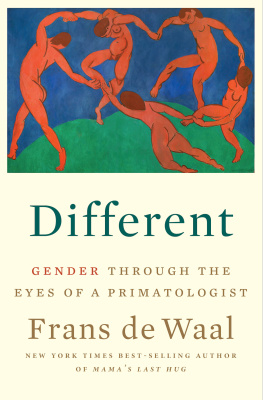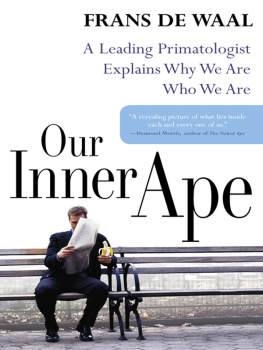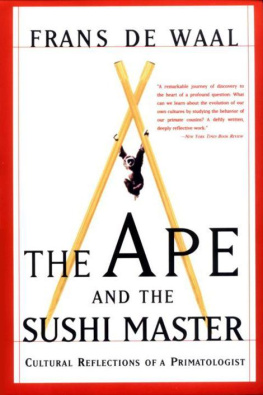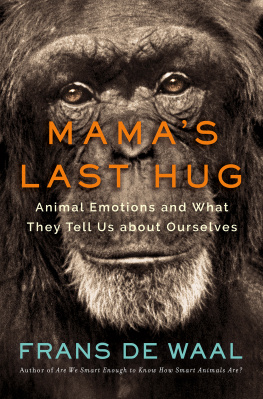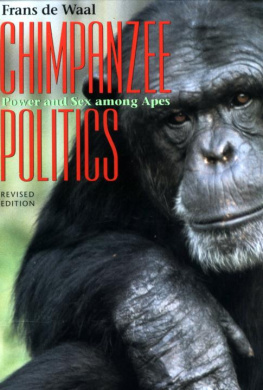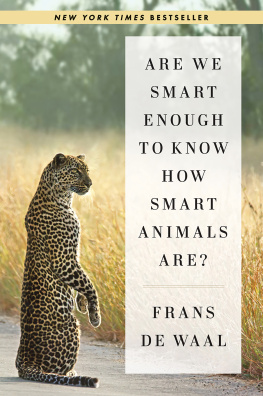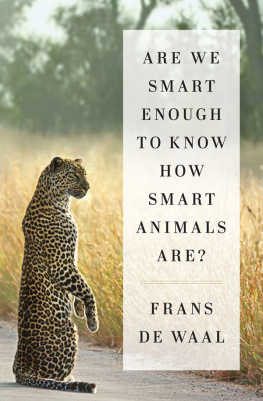Contents
Guide

Other books by Frans de Waal
Mamas Last Hug (2019)
Are We Smart Enough to Know How Smart Animals Are? (2016)
The Bonobo and the Atheist (2013)
The Age of Empathy (2009)
Primates and Philosophers (2006)
Our Inner Ape (2005)
My Family Album (2003)
The Ape and the Sushi Master (2001)
Bonobo: The Forgotten Ape (1997)
Good Natured (1996)
Peacemaking Among Primates (1989)
Chimpanzee Politics (1982)
DIFFERENT
GENDER THROUGH THE EYES
OF A PRIMATOLOGIST
Frans de Waal
With drawings & photographs by the author

For Catherine, who makes all the difference
CONTENTS
DIFFERENT
T he saddest day of my career began with a phone call telling me that my favorite male chimpanzee had been butchered by two rivals. Having hurried on my bike to Royal Burgers Zoo, in the Netherlands, I found Luit sitting in a puddle of blood, leaning his head dejectedly against the bars of his night cage. Normally aloof, he heaved the deepest sigh when I stroked his head. It was too late, though. He died the same day on the operating table.
Rivalry among male chimps can grow so intense that they kill each other, and not only at the zoo. There are now a dozen reports of high-ranking males slain in the wild during the same sort of power struggles. While jockeying for the top spot, males opportunistically make and break alliances, betray each other, and plot attacks. Yes, plot, because it was no accident that the assault on Luit took place in the night quarters where three adult males were kept apart from the rest of the colony. Things might have unfolded differently out on the large forested island of the worlds best-known chimpanzee colony. Female chimps dont hesitate to interrupt clashes among male contenders. While Mama, the alpha female, couldnt keep the males from politicking, she did draw the line at bloodshed. Had she been present on the scene, shed no doubt have rallied her allies to step in.
Luits untimely death affected me deeply. He had been such a friendly character, who as leader had brought peace and harmony. But on top of that, I was deeply disappointed. Until then, the battles I had witnessed had always ended in reconciliation. Rivals would kiss and embrace after each skirmish and were perfectly capable of handling their disagreements. Or so I thought. Adult male chimps act like friends most of the time, grooming each other, and roughhousing in fun. The disastrous fight taught me that things can also spiral out of control and that the same males are capable of intentionally killing each other. Fieldworkers have described assaults in the forest in similar tones. They seem deliberate enough to speak of murder.
The high-intensity aggression of male chimps has a female equivalent. The circumstances that trigger female anger are quite different, though. Even the biggest male knows that every mother will turn into a raging hurricane if he lifts a finger against her progeny. She will become so undaunted and fierce that nothing will stop her. The ferocity with which a mother ape defends her young exceeds that with which she defends herself. Maternal protectiveness is such a universal mammalian trait that we joke about it, such as when U.S. vice-presidential candidate Sarah Palin called herself a Mama Grizzly. Mindful of this reputation, Gary Larson drew a cartoon in which a businessman carrying a briefcase enters an elevator with a large and a small bear standing in the back. The caption reads: Tragedy struck when Conroy, his mind preoccupied with work, stepped into the elevatordirectly between a female grizzly and her cub.
The greatest fear of fandis in the jungles of Thailandhunters who in the old days captured wild elephants for timber laborwas not that theyd snare a tusker. A large bull in the ropes posed less acute danger than a small calf captured while its mother was within hearing range. Quite a few fandis have lost their lives to enraged elephant cows.
In our species, a mothers defense of her children is so predictable that, according to the Hebrew Bible, King Solomon counted on it. Faced with two women who both claimed to be the mother of a baby, the king asked for a sword. He proposed to split the baby so that each woman could have half of it. While one woman accepted the verdict, the other protested and pleaded that the baby be given to the other. This is how the king knew who the real mother was. As the British detective writer Agatha Christie put it, A mothers love for her child is like nothing else in the world. It knows no law, no pity, it dares all things and crushes down remorselessly all that stands in its path.
While we admire mothers who take their childrens side, we hold a dim view of human male combativeness. Boys and men often instigate confrontations, act tough, hide vulnerabilities, and seek danger. Not everyone likes men for this, and some experts disapprove. When they say that traditional masculinity ideology fuels mens behavior, they hardly mean it as a compliment. In a 2018 document, the American Psychological Association defined this ideology as revolving around anti-femininity, achievement, eschewal of the appearance of weakness, and adventure, risk, and violence. The APAs attempt to save men from this ideology revived debate about toxic masculinity but also triggered backlash over its blanket denunciation of typical male behavior.
Its easy to see why male and female patterns of aggression are valued so differently: only the first creates trouble in society. Horrified by the death of Luit, I dont want to depict male rivalry as an innocuous pastime. But who says its a product of ideology? A huge assumption is being made here, which is that we are the masters and designers of our own behavior. If this were true, shouldnt it stand apart from that of other species? But it hardly does. In most mammals, males strive for status or territory whereas females vigorously defend their young. Whether we approve or disapprove of such behavior, its not hard to see how it evolved. For both sexes, it has always been the ticket to a genetic legacy.
Ideology has little to do with it.
S EX DIFFERENCES IN animal and human behavior raise questions that lie at the heart of almost any debate about human gender. Does the behavior of men and women differ naturally or artificially? How different are they really? And are there only two genders, or are there more?
But before I dive into this topic, let me make clear why I am interested in it and where I stand. I am not here to justify existing human gender relations by describing our primate heritage; nor do I think that everything is fine as it is. I recognize that the genders are not now and have never been equal for as long as we can remember. Women get the short end of the stick in our society and in almost every other one. They have had to fight for every improvement, from the right to education to voting rights, and from legalized abortion to equal pay. These arent little improvements. Some rights have been secured only recently, some are still being resisted, and some were achieved but have come under fresh attack. I see all this as highly unfair and consider myself a feminist.
Disdain for the innate abilities of women has a long tradition in the West going back at least two millennia. Its the way gender inequality has always been justified. Thus the nineteenth-century German philosopher Arthur Schopenhauer thought that all their lives women remain children, who live in the present, whereas men have the ability to think ahead. Another German philosopher, Georg Wilhelm Friedrich Hegel, thought that men correspond to animals, while women correspond to plants.

